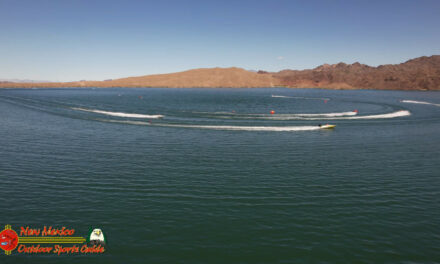If you were to look in a professional angler’s boat during practice before a big tournament, chances are you would see topwaters, spinnerbaits, and lipless crankbaits. They would either be on the deck or within easy reach in most every rod box. The main reason for having these baits tied on at all times is that these are fish finding and fish catching baits that always work.
TOPWATER action is by far the most exciting way to catch bass, especially in the early hours before the sun gets up, late evenings or during low light (cloudy) conditions. Watching a bass come up to the surface and inhale a bait is breathtaking. It seems like time stops for that particular moment when the explosion occurs and the bait disappears from the surface. There is a moment when you think, have I got her, did I miss her, is she on; and then in an instant, you feel that pulsating pull against the line, and you know the battle is on!
Topwaters are really at their peak when there is a light ripple or small chop on the water. If there is no ripple or chop, the fish will be easily spooked and wary of topwaters and it’s probably best to go to a subsurface bait like a spinnerbait. When fishing in shallow water, topwater fishing may be the most exciting way to catch bass, but it is also the first pattern to go under frontal conditions. Because adverse weather affects shallow water patterns, the pros have learned over years of experience to never depend exclusively on a topwater pattern to hold out for an entire tournament. Topwaters fall into five basic categories based on size and type of bait which are: cigar, stick, slush, popper and buzz baits. With hundreds of topwater baits to choose from, how do you know which ones are going to produce? The all time favorite has got to be Heddon’s Zara Spook using a “walk the dog” type of cadence to produce really big bass. The term, “walking the dog” means, cast your bait out past the target and work it back with your rod tip pointed towards the water and leaving the line slack (not tight). Pop the bait with a short jerk or twitch and then pop the bait again which will make it move from side to side in a stop/go pause continuing cadence. If the bait does not move from side to side, chances are you have too much slack line out. Reel some of it up but not all as this method works best on slack line. The “walk the dog” action resembles a wounded bait fish fluttering on the surface and is an easy prey for the bass. They will inhale the bait by flaring their gills and sucking it down. You don’t want to set the hook when you see the fish explode on top of the bait. You want to wait until you feel the fish pulling the bait down, then set the hook. This is one of the hardest lessons to learn with topwaters. It’s totally unnerving and almost impossible to do, but if you set the hook too soon, the fish won’t be there because you have pulled the bait away before the fish connected; and, if you wait too long, the bass may spit the bait out. There is a very fine line there and only experience will tell you when to set the hook.
When Zell Roland of the Skeeter/Yamaha Pro Team presents a seminar, he talks about the Spook and discusses various ways of modifying the bait to give the pros that extra advantage. The older spooks with three sets of treble hooks are the best. Also, when fishing topwater cigar baits, the Zara Puppy is very effective on school bass.
When you get into slush baits (baits with propellers on either the front, rear or both), Cordell’s Bow Howdy and the Crazy Shad, along with Smithwick’s Devil’s Horse, and Heddon’s Tiny Torpedo are classic baits. Slush baits are fished with short, erratic twitches and semi slack line. For additional action, instead of tying the knot directly to the snap ring, many of the pros tie their topwater baits with a “Loop” knot which imparts more lifelike action to the bait. Slush baits are best when used from post spawn on through the summer’s school fish and continue to work through early fall. Stick baits such as the traditional Smithwick Rogue, Cordell Red Fin, Pencil Popper and Bomber Long A’s, are hard plastic jerkbaits fished with long sweeps or short jerks. Slush baits are designed to not only resemble and have the action of a wounded minnow, but also to make distinctive noises of a shad thrashing on the surface which adds an extra enticement to attract bass that may be passing by.
One of the favorite poppers of all times has got to be the famous Rebel Pop R. This bait has been around for at least twenty years. It was discontinued for awhile in the `80’s and with increased demand from the pros, especially Zell Roland, the “Pop R King,” it was brought back into production and has danced and popped it’s way into the money. Zell has propelled himself, the Pop R and his Boots Follmar Marine Skeeter/Yamaha into the history books with his mastery of this one bait; and, it’s deadly presentation on the water. He uses feathers of many colors, whittles, repaints, refinishes, weights, scrapes and does a major overhaul on this very famous Pradco bait, and when it gets down to the battle, you can bet he’ll come out with just the right Pop R combination to clinch the day! When bass are chasing shad, especially in the fall, this bait can be popped, gurgled and teased back to the boat or it can be steadily worked in the “walking the dog” method.
Storm’s Rattling Chug Bug is another excellent popper bait that is fished in the same manner, but it has rattles to further entice the bass. Excalibur’s Spit’n Image is a minnow like bait (bottom weighted) that is also retrieved in the side to side motion and it’s sputtering action has been very effective on school fish. As always, the pro anglers have found ways to modify these baits and their secret changes will most likely go to their graves with them.
A bait that every angler should have several of is a buzzbait. My husband, Norman, caught one of his biggest bass ever on Richland Chambers (see photo) on the 3/8 oz. Lunker Lure. It also comes in a 1/4 oz. size. These baits are highly effective when fished over vegetation and can even be used in the dead of winter over open water to catch giant bass. This is one of the easiest baits of all to use, just throw it out and reel it very fast until the bait stays up on the surface of the water and reel it like that all the way back to the boat. John Hope, of the infamous Tracking Texas Trophies segment, told me long ago that when you listen to this bait as it is reeled straight up off the bottom, it sounds like a ball of shad coming to the surface. There are many manufacturers of this bait including Lunker Lure, Excalibur, Stanley, Mr. Blitz, Strike King, Blue Fox, Harts and many more. Primary colors are white and white/chartreuse. Blade colors would be picked the same as in spinnerbaits and determined by water clarity.
LIPLESS CRANKBAITS are great tools to locate bass. I can’t tell you how many big tournaments have been won on this particular kind of bait, but it has been a lot, especially in lakes with vegetation. These baits can be cranked down to the top of the grass, ticked across and then ripped through the grass, and if a bass is anywhere near, trigger a strike. Although there are many manufacturers, the two major producers are Cordell’s Hot Spot and Bill Lewis’ Rat-L-Trap. Both baits are shad shaped, come in almost any size range, and are hollow baits with rattle chambers added for sound and weight. I call these baits fish magnets because they will draw the fish out when nothing else seems to work! The original Rat-L-Trap comes in over 50 colors to choose from, but again, if your just starting out, stick to the primary colors. This bait works year-round, using the smaller sizes in early spring and as the water warms going to the larger sizes in the fall. If you examined every boat on a given body of water, most all of them would have these baits not only on board, but tied on to at least one rod!
The setup you use (rods, reels and line), is just as important as the baits you throw and the balance is critical to your overall success. Norman and I use CastAway Surface Bait Casting, Jerk & Twitch, Soft Touches and Launcher rods for most of these baits, but any quality medium action fast tip rod would be suitable. We also use Daiwa Millionaire, Procaster Z and Team Daiwa series 5:1 ratio reels for our topwater baits, spinnerbaits and lipless crankbaits, spooled with Berkley Big Game Green line in 12-15 pound test. There are other quality rods and reels on the market, but our personal preference is for Daiwa reels and CastAway graphite rods.
LAST, BUT NOT EVER DISCOUNTED ARE SPINNERBAITS. There are very few things that professional anglers agree on, but the bait of choice and in most all arsenals, will be a spinnerbait. The reason is strictly in the numbers. More money has been made on the tournament trails using a spinnerbait than any other bait! Spinnerbaits are easy to use, versatile and can cover lots of water and all depths of water in a short period of time.
Where many anglers get confused about spinnerbaits is trying to figure out which configuration of spinnerbait to use on a particular body of water, under a certain set of conditions, taking into account such factors as: water clarity, light penetration, time of year and depth fishing. Additional factors are blade configuration, spinnerbait weight/size and skirt color. A spinnerbait is an easy bait to use because you basically cast it out and reel it back, pretty simple, right? Ah, but learning the right configuration and components of the bait is what separates the fish catching from the fish wishin’ anglers. Sometimes
it appears as though there are thousands of combinations and variables to confuse the ordinary angler.
So how do you narrow down the options to select the appropriate bait for the cir*****stances at hand? Break the spinnerbait down into the four basic components: composition, blade, weight and color. To keep it really simple, take color first because it is the easiest. For clear water, neutral, translucent and white colored skirts work the best. For dingy or stained water, use chart./white, blue or punkinseed or a combination thereof; and in muddy water use, black, orange or chartreuse.
Second, consider the composition. There are three kinds of spinnerbaits, in-line, short arm and long arm. In-line spinnerbait means that the spinners (blades) are in direct line with the hook, such as the Snagless Sally or Mepps Rooster tails. They are primarily used in northern waters. In-lines can also be fished around brush and timber and can be buzzed just under the surface.
Both short arm and long arm spinnerbaits are safety pin baits. The long arm baits are easier to get through grass and are more weedless due to the arm of the bait being directly over the hook. Short arms are used as a drop bait as the blade is directly over the head of the lure which lets it spiral down (helicopter) to the bottom. There are many manufacturers of these types of spinnerbaits. The cost range can be as economical as an H&H for less than a buck, to the higher profile and more expensive type, such as the Terminator with a titanium wire base arm that claims to never have to be adjusted. Excalibur, Strike King and Stanley are major manufacturers of high quality spinnerbaits which are mass produced. There are also smaller, regionally defined manufacturers that are equally, if not better than some of the well known baits. Mr. Blitz spinnerbaits are made in Hemphill, Texas, and have been around Toledo Bend and Sam Rayburn for years, but as touring national pros use and promote this local bait, it is gaining in popularity and becoming more widely known. The reason for its success is due to the quality control that goes into every hand built bait.
No discussion of spinnerbaits can be complete without addressing the various blade configurations and blade color(s) used in the assembly process. There are basically three primary blade types: Colorado, Indiana or willowleaf and numerous combinations such as the thumper, tortoise shell and pear shaped blades. In order to choose the appropriate blade, first determine the water clarity which will tell you whether the fish are feeding by sight or sound. Colorado blades are used primarily in stained to muddy water or low light conditions where the fish are feeding by sound and bait vibration is the key factor. Also, under these conditions for maximum throb and vibration, the Indiana or Thumper blades would be used. Tandem willowleaf blades will work the best under clear water conditions with vegetation because the blades have a tighter rotation and will tangle less in the grass. Willowleaf blades have the least vibration, most flash and come through grass the best. Use chrome or nickel blades when fishing clear water because these fish are feeding by sight. In stained to muddy water, use copper, gold or painted blades. When your not sure what blade configuration to go with, start out with double blades, one silver and one copper. Let the fish tell you what they want.
A single Colorado blade works best when you want more vibration in dingy to stained water conditions. This also holds true for night fishing and fishing in the summertime. Use double Colorado blades when you want to v-wake the bait just under the surface, especially in the fall. The thumper blades are great to slow roll or drop. The larger the blades the more lift the lure will have. A single blade bait has more vibration than a tandem willowleaf bait, and finally, Colorado blades have more vibration than the willowleaf but not as much vibration as the Indiana blades.
It is fairly easy to determine the spinnerbait weight. You want to be able to feel the bait vibrate as the blades are pulled through the water. If you cannot feel the vibration, change weight size. Basically, four sizes will get you through most situations. ¼ oz, 3/8 oz., ½ oz. or 3/4 oz. Water temperature is a key factor to determining the weight of the spinnerbait because different times of the year require different weight sizes. Again fall back on whether or not you can feel the blades turning and vibrating as they come through the water. Experiment and practice is the best answer to which bait will work best for you. Spinnerbaits can be fished from the surface to the bottom and anywhere in between. During the winter, I like to use a 3/4 oz. bait and slow roll it over the vegetation or let it drop to the bottom and work it back much like a worm. During the spring and fall, depending on the water clarity and temperature, I like to use a ¼ oz. up shallow and a 3/8 to ½ oz. in the deeper waters. When fishing in the heat of the summer, you can’t beat a 3/8 oz. tandem willowleaf in and around the vegetation, or a single Colorado blade which provides a lot of vibration.
Why it is that bass fishermen/women can never have enough tackle? Starting out, it’s best to keep colors to a minimum of chrome, shad, crawfish, chartreuse and firetiger, which are all basic colors in the food chain. We constantly go to the tackle store and stand gawking and mystified at the variety of sizes, shapes and colors of baits. None of us has the will power to leave the store with just one bait! Tackle stores are designed to catch anglers, then bass, and no matter how many baits we have, more is always better because they are Efficient, Always Successful, Year-round Baits! – Lake Havasu
– Lake Havasu












